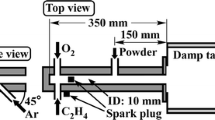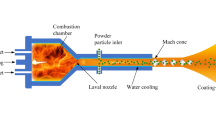Abstract
Detonation spraying is a technique that uses the high-temperature, high-velocity detonation waves to deposit the molten metal particles onto the target surface. The effect of the detonation spraying is influenced by the structure of the gun significantly. A series of detonation spraying gun two-dimensional (2-D) numerical models with various spray gun structures (slope lengths from 5 to 45 mm with a step of 10 mm) were established in this work, to investigate the spray performance. During the process of gas detonation, the interaction between the detonation wave and obstacles results in the generation of reflected waves, which exerts an accelerating effect on flame. Simultaneously, collisions between the flame front and obstacles introduce energy losses. Based on the above factors, the following results can be obtained: when the slope length at the nozzle diameter change point is 5 mm, the maximum flow velocity is achieved at the spray gun outlet. When the slope length at the transition point of the spray gun is 25 mm, the maximum temperature is reached at the spray gun outlet. When the slope length at the transition point of the spray gun is 45 mm, the maximum pressure is reached at the spray gun outlet. This work can contribute to the design of the detonation gun.

















Similar content being viewed by others
References
C. Senderowski, A. Panas, B. Fikus, D. Zasada, M. Kopec, and K. Korytchenko, Effects of Heat and Momentum Gain Differentiation during Gas Detonation Spraying of FeAl Powder Particles into Water, Materials, 2021, 14, p 7443.
B. Fikus, C. Senderowski, and A. Panas, Modeling of Dynamics and Thermal History of Fe40Al Intermetallic Powder Particles Under Gas Detonation Spraying Using Propane-Air Mixture, J Therm Spray Tech, 2019, 28, p 346-358.
Z. Pu, K. Yang, Z. Liu, and X. Mao, Numerical Simulation of Temperature Field During Electrothermal Explosion Spray Coating, J. Mech. Eng., 2005, 41, p 142.
S. Yao, X. Tang, and W. Zhang, Structure of a Heterogeneous Two-Phase Rotating Detonation Wave with Ethanol-Hydrogen-Air Mixture, Phys. Fluids, 2023, 35, p 031712.
S. Ramachandran, N. Srinivasan, Z. Wang, A. Behkish, and S. Yang, A Numerical Investigation of Deflagration Propagation and Transition to Detonation in a Microchannel with Detailed Chemistry: Effects of Thermal Boundary Conditions and Vitiation, Phys. Fluids, 2023, 35, p 0155645.
W. Han, Y. Gao, and C.K. Law, Flame Acceleration and Deflagration-to-Detonation Transition in Micro-and Macro-Channels: An Integrated Mechanistic Study, Combust. Flame, 2017, 176, p 285.
A. Wang, J. Bian, and H. Teng, Numerical Study on Initiation of Oblique Detonation Wave by Hot Jet, Appl. Therm. Eng., 2022, 213, p 118679.
S. Zhao, Y. Fan, H. Lv, and B. Jia, Effects of a Jet Turbulator Upon Flame Acceleration in a Detonation Tube, Appl. Therm. Eng., 2017, 115, p 33.
Y. Liu, H. Shen, D. Zhang, and Z. Jiang, Theoretical Analysis on Deflagration-to-Detonation Transition, Chinese Phys. B., 2018, 27, p 084703.
J. Cheng, B. Zhang, H. Liu, and F. Wang, Experimental Study on the Effects of Different Fluidic Jets on the Acceleration of Deflagration Prior its Transition to Detonation, Aerosp. Sci. Technol., 2020, 106, p 106203.
D. Kessler, V. Gamezo, and E. Oran, Simulations of Flame Acceleration and Deflagration-to-Detonation Transitions in Methane-Air Systems, Combust. Flame, 2010, 157, p 2063.
F. Zhou, N. Liu, and X. Zhang, Numerical Study of Hydrogen-Oxygen Flame Acceleration and Deflagration to Detonation Transition in Combustion Light Gas Gun, Int. J. Hydrogen Energy, 2018, 43, p 5405.
K. Iwata, Numerical Approach to Theoretical Aspects of Wedge-Induced Oblique Detonation Wave in a Hydrogen Concentration Gradient, Phys. Fluids, 2023, 35, p 0156540.
K. Ramadan and P.B. Butler, A Two-Dimensional Axisymmetric Flow Model for the Analysis of Pulsed Detonation Thermal Spraying, Combust. Sci. Technol., 2003, 175, p 1649.
T. Gavrilenko, Y. Nikolaev, V. Ulianitsky, M. Kim, and J. Hong. Computational code for detonation spraying process. In ITSC 1998 (pp. 1475-1483). ASM International.
T.P. Gavrilenko and Yu.A. Nikolaev, Calculation of Detonation Gas Spraying, Combust. Explos. Shock Waves, 2007, 43, p 724-731.
I.S. Batraev, E.S. Prokhorov, and V.Y. Ul’yanitskii, Acceleration and Heating of Powder Particle by Gas Detonation Products in Channels with Cone Transition, Combust. Explos. Shock Waves, 2014, 50(3), p 1-9.
V. Ulianitsky, A. Shtertser, S. Zlobin, and I. Smurov, Computer-Controlled Detonation Spraying: From Process Fundamentals Toward Advanced Applications, J. Therm. Spray Technol., 2011, 20(4), p 791-801.
K. Kailasanath, G. Patnaik, and C. Li, The Flowfield and Performance of Pulse Detonation Engines, P. Combust. Inst., 2002, 29, p 2855.
S. Liu, Research on Deflagration to Detonation Transition Characteristics and Mechanism of Gas-phase Propane, Harbin Engineering University, 2021 (in Chinese).
J. Li, W.-H. Lai, and K. Chung, Tube Diameter Effect on Deflagration-to-Detonation Transition of Propane-Oxygen Mixtures, Shock Waves, 2006, 16, p 109.
S. Liu, X. Chen, N. Zhao, H. Zheng, and X. Jia, Experimental Study on Initiation and Propagation Behavior of Propane/Oxygen/Nitrogen Detonation Wave, Fuel, 2021, 293, p 120487.
Y. Wu, Q. Zheng, and C. Weng, An Experimental Study on the Detonation Transmission Behaviours in Acetylene-Oxygen-Argon Mixtures, Energy, 2018, 143, p 554.
G. Ciccarelli and M. Cross, On the Propagation Mechanism of a Detonation Wave in a Round Tube with Orifice Plates, Shock Waves, 2016, 26, p 587.
H. Xu, X. Ni, X. Su, C. Weng, and C. Yao, The Effect of Ignition Intensity and in-Cylinder Pressure on the Knock Intensity and Detonation Formation in Internal Combustion Engines, Appl. Therm. Eng., 2022, 200, p 117690.
R. Zou, J. Liu, and N. Wang, Effect of Recess Shape on Combustion Performance and Knocking Characteristics for a Downsized Gasoline Rotary Engine, Appl. Therm. Eng., 2022, 214, p 118758.
Y. Zhu, K. Wang, M. Zhao, Z. Wang, and W. Fan, Experimental Study on Wave Propagations in a Rotating Detonation Chamber with Different Outlet Configurations, Acta Astronaut., 2022, 200, p 388.
C. Jiang, J. Pan, J. Weng, J. Li, and E.K. Quaye, Role of Concentration Gradient in the Re-initiation of H2/O2 Detonation in a 90° Bifurcated Channel, Aerosp. Sci. Technol., 2022, 120, p 107281.
C. Jiang, J. Pan, Y. Zhu, J. Li, H. Chen, and E.K. Quaye, Influence of Concentration Gradient on Detonation Re-initiation in a Bifurcated Channel, Fuel, 2022, 307, p 121895.
G. Goodwin, R. Houim, and E. Oran, Effect of Decreasing Blockage Ratio on DDT in Small Channels with Obstacles, Combust. Flame, 2016, 173, p 16.
C. Movileanu, M. Mitu, V. Giurcan, D. Razus, and D. Oancea, Quenching Distances, Minimum Ignition Energies and Related Properties of Propane-Air-Diluent Mixtures, Fuel, 2020, 274, p 117836.
Y. Ruiguang, L. Jie, and M. Biao, Effect of Methanol on Explosion Limits of Propane-Oxygen Mixture, CIESC J., 2021, 72, p 3411.
D. Yap, J. Karlovsky, A. Megaritis, M. Wyszynski, and H. Xu, An Investigation into Propane Homogeneous Charge Compression Ignition (HCCI) Engine Operation with Residual Gas Trapping, Fuel, 2005, 84, p 2372.
Y. Mu, D. Zheng, Y. Wang, L. Li, and H. Zhang, Numerical Simulation Analysis for Low Temperature Plasma Ignition of Propane/Air, Acta Scientiarum Naturalium Universitatis Pekinensis, 2015, 791 (in Chinese).
B. Zhang and C. Bai, C2H4-O2 Critical Energy for Direct Detonation of C2H4-O2 Gas Mixture, Explos. Shock Waves, 2012, 32(2), p 113-120. (in Chinese)
B. Zhang, M. Shahsavari, J. Chen, H. Wen, B. Wang, and X. Tian, The Propagation Characteristics of Particle-Laden Two-Phase Detonation Waves in Pyrolysis Mixtures of C (s)/H2/CO/CH4/O2/N2, Aerosp. Sci. Technol., 2022, 130, p 107912.
J. Yu, L. He, W. Ding, Y. Zhang, Y. Mao, and Y. Jiang, Comparative Study of Transient Plasma Ignition and Spark Plug Ignition Initiation Process, Propuls. Technol., 2013, 34, p 1575. (in Chinese)
42nd AIAA M. Petrova, B. Varatharajan, and F. Williams, Theory of Propane Autoignition, Aerospace Sciences Meeting and Exhibit. 2004.
V.Y. Ulianitsky, D.V. Dudina, A.A. Shtertser, and I. Smurov, Computer-Controlled Detonation Spraying: Flexible Control of the Coating Chemistry and Microstructure, Metals, 2019, 9, p 1244.
W. Krömmer, P. Heinrich, and H. Kreye, High Velocity Oxy-Fuel Flame Spraying: Past-Present-Future. Proceedings of 8th Colloquium High Velocity Oxy-Fuel Flame Spraying. 2009, 9-16.
K. Bobzin, N. Kopp, T. Warda, I. Petkovic, M. Schaefer, K.D. Landes, G. Forster, S. Zimmermann, J.L. Marques, S. Kirner, and M. Kauffeldt, Particle in-Flight and Coating Properties of Fe-Based Feedstock Materials Sprayed with Modern Thermal Spray Systems, J. Therm. Spray Technol., 2013, 22, p 363-370.
V. Ulianitsky, I. Batraev, D. Dudina, and I. Smurov, Enhancing the Properties of WC/Co Detonation Coatings Using Two-Component Fuels, Surface Coat. Technol., 2017, 318, p 244-249.
V.Y. Ul’yanitskii, A.A. Shtertser, and I.S. Batraev, Detonation of a Gas Fuel Based on Methyl Acetylene and Allene, Combust. Explos. Shock Waves, 2015, 51(2), p 246-251.
Acknowledgment
This work is supported by the National Natural Science Foundation of China (52325604), the National Science and Technology Major Project (J2019-III-0005-0048), MOST (2021YFA0716200/2022YFB4003900), CAS Project for Young Scientists in Basic Research (YSBR-028) and the Innovation Academy for Light-duty Gas Turbine, Chinese Academy of Sciences, Innovation guidance youth project (CXYJJ21-QN-001).
Author information
Authors and Affiliations
Corresponding authors
Additional information
Publisher's Note
Springer Nature remains neutral with regard to jurisdictional claims in published maps and institutional affiliations.
Rights and permissions
Springer Nature or its licensor (e.g. a society or other partner) holds exclusive rights to this article under a publishing agreement with the author(s) or other rightsholder(s); author self-archiving of the accepted manuscript version of this article is solely governed by the terms of such publishing agreement and applicable law.
About this article
Cite this article
Li, HK., Wang, D., Cui, YJ. et al. Study of the Propane Detonation Spraying under Different Gun Structures. J Therm Spray Tech (2024). https://doi.org/10.1007/s11666-024-01793-5
Received:
Revised:
Accepted:
Published:
DOI: https://doi.org/10.1007/s11666-024-01793-5




